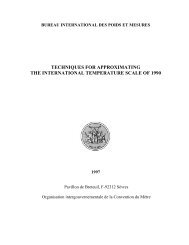On the measurement quality of UTC time transfer - BIPM
On the measurement quality of UTC time transfer - BIPM
On the measurement quality of UTC time transfer - BIPM
You also want an ePaper? Increase the reach of your titles
YUMPU automatically turns print PDFs into web optimized ePapers that Google loves.
For <strong>the</strong> MC links equipped with HM clocks, <strong>the</strong> optimal smoothing is likely to be Vdk0. The σ varies between<br />
0.290 ns (NICT-PTB, about 10,000 km in distance and <strong>the</strong> longest baseline in <strong>the</strong> <strong>UTC</strong> network) to 0.573 ns<br />
(TL-PTB, also a very long Asia-Europe baseline). The average is 0.433 ns. This is much lower than <strong>the</strong><br />
conventional uA (MC) 1.5 ns. If <strong>the</strong> Vondrak smoothing power is optimal, <strong>the</strong> potential uA <strong>of</strong> GPS MC would be<br />
0.5 ns to 0.8 ns for <strong>the</strong> stable clock <strong>transfer</strong>s. For <strong>the</strong> clocks with background noise, <strong>the</strong> power <strong>of</strong> <strong>the</strong> smoothing<br />
provides no obvious influence statistically. Generally speaking, a lower smoothing, e.g. Vdk0 or Vdk1, is more<br />
suitable for <strong>the</strong> MC C/A link and this greatly increases <strong>the</strong> <strong>quality</strong> <strong>of</strong> <strong>UTC</strong> links <strong>of</strong> which nearly half are <strong>of</strong> <strong>the</strong><br />
C/A code. The Vdk4 power used seems too high.<br />
Similar to <strong>the</strong> above, we studied GPS P3. Table 10 lists <strong>the</strong> results. As for those results provided in Table 9, for<br />
<strong>the</strong> stable maser baselines, <strong>the</strong> lower power smoothing suggests significant gains, e.g. for <strong>the</strong> baseline ROA-<br />
PTB, <strong>the</strong> σ <strong>of</strong> <strong>the</strong> standard smoothing Vdk5 is 0.659 ns while that <strong>of</strong> Vdk1 is only 0.208 ns, three <strong>time</strong>s smaller,<br />
noting again that <strong>the</strong> conventional uA <strong>of</strong> GPSPPP is 0.3 ns!<br />
Table 10 Comparison <strong>of</strong> σ between <strong>the</strong> GPSPPP and GPS P3 links with different Vondrak smoothing powers (using <strong>the</strong> 1101 data, Vdkx<br />
stands for <strong>the</strong> Vondrak smoothing with <strong>the</strong> smoothing power x, <strong>the</strong> number <strong>of</strong> <strong>the</strong> compared points and <strong>the</strong> σ are listed)<br />
Smooth IT-PTB OP-PTB SG-PTB TL-PTB KRIS-PTB NICT-PTB ROA-PTB USNO-PTB SP-PTB ORB-PTB.<br />
_ _ ___/ns /ns /ns /ns /ns /ns /ns /ns /ns /ns<br />
Vdk9 2869 0.249 2526 0.470 3003 0.438 2919 0.333 3017 0.419 3006 0.579 2895 0.938 2927 0.484 3002 0.372 2965 0.699<br />
Vdk8 2869 0.214 2523 0.439 3003 0.410 2918 0.291 3017 0.371 3007 0.522 2881 0.890 2925 0.440 3001 0.339 2959 0.670<br />
Vdk7 2868 0.184 2518 0.424 3003 0.368 2918 0.269 3016 0.311 3006 0.391 2859 0.797 2921 0.400 3001 0.297 2939 0.694<br />
Vdk6 2868 0.160 2510 0.438 3003 0.337 2918 0.247 3015 0.237 2996 0.263 2830 0.726 2918 0.357 3001 0.261 2905 0.775<br />
Vdk5 2868 0.143 2506 0.467 3001 0.328 2918 0.226 3016 0.176 2989 0.234 2805 0.659 2919 0.328 3001 0.238 2834 0.899<br />
Vdk4 2868 0.127 2504 0.513 3001 0.302 2918 0.208 3015 0.159 2985 0.203 2780 0.443 2920 0.309 3000 0.184 2703 1.002<br />
Vdk3 2868 0.124 2485 0.607 2999 0.289 2918 0.198 3014 0.151 2977 0.181 2694 0.251 2918 0.290 2997 0.137 2861 1.242<br />
Vdk2 2868 0.125 2429 0.747 2998 0.300 2918 0.195 3015 0.179 2973 0.177 2659 0.220 2917 0.278 2997 0.129 2759 1.357<br />
Vdk1 2868 0.130 2318 0.855 2998 0.334 2918 0.194 3009 0.273 2972 0.175 2646 0.208 2917 0.270 2998 0.127 2843 1.629<br />
Vdk0 2868 0.149 2482 1.053 2994 0.370 2918 0.197 3000 0.391 2969 0.180 2646 0.219 2917 0.269 2999 0.153 2736 1.883<br />
We conclude that a stronger smoothing for <strong>the</strong> baselines with stable clocks (clock noise less than link noise)<br />
allows <strong>the</strong> <strong>measurement</strong> uncertainty reduced for GPS MC C/A within 0.5-0.8 ns and for GPS P3 within 0.2-0.5<br />
ns. The TW links may also be improved with a 10% gain.<br />
4. Re-evaluation <strong>of</strong> <strong>the</strong> uA’ for all <strong>the</strong> present <strong>UTC</strong> links<br />
Multi indicators are used to estimate <strong>the</strong> uA’ as discussed in sections 2 and 3.3: σ, σ and TDev/τ, cf. <strong>the</strong> notation<br />
for <strong>the</strong> meaning. We also investigated <strong>the</strong> relationship between <strong>the</strong>se indicators. This is particularly useful for <strong>the</strong><br />
baselines where <strong>the</strong> high category link is not available. The ‘old’ evaluation <strong>of</strong> uA is considered as <strong>the</strong> a priori<br />
estimation and <strong>the</strong> experience accumulated from observations over <strong>the</strong> last decade <strong>of</strong> <strong>the</strong> <strong>UTC</strong> links are<br />
considered.<br />
Numerical analysis and statistics are based on long-term data at least nine months from 1101 to 1109. A poor<br />
historical record in a link during this period may degrade <strong>the</strong> uA estimation.<br />
The difficulty in separating <strong>the</strong> instabilities <strong>of</strong> <strong>the</strong> clock in Lab(k) from those <strong>of</strong> <strong>the</strong> link <strong>measurement</strong>s between<br />
Lab(k) and <strong>the</strong> pivotal laboratory PTB remain. The instability <strong>of</strong> <strong>the</strong> HM at <strong>the</strong> PTB, for example, can be<br />
considered negligible, at least for <strong>the</strong> less stable categories. The uA’ values given in Table 11 partially mask clock<br />
instability. If <strong>the</strong> TDev contains some clock instability, it is not critical, since we prefer to give a uA’ value that is<br />
ra<strong>the</strong>r conservative.<br />
Table 11 lists <strong>the</strong> ‘old’ uA values <strong>of</strong> <strong>the</strong> <strong>UTC</strong> <strong>time</strong> links as given in <strong>the</strong> Section 6 <strong>of</strong> <strong>BIPM</strong> Circular T [1] and <strong>the</strong><br />
‘new’ uA’ values obtained from this reevaluation. Here: TDev/τ = <strong>the</strong> conventional value <strong>of</strong> <strong>time</strong> deviation in<br />
nanoseconds for averaging <strong>time</strong> τ in a hour. The minimum value is 0.1 ns even if <strong>the</strong> true value is less than that.<br />
In <strong>the</strong> TDev/τ column, * stands a TDev value dominated by clock noise and not applicable for uA’. These new<br />
evaluations have been applied in Circular T 287 published since in December 2011 [20].<br />
13
















